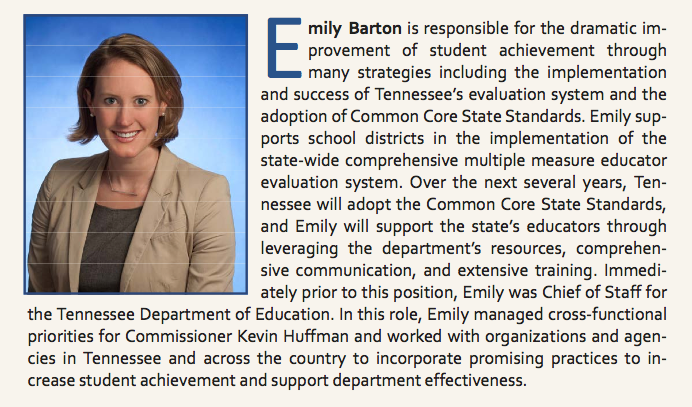A few weeks ago, the writers behind TNEdReport met in a conference room to interview Dr. Jay Steele, the Chief Academic Officer for MNPS. We had a great conversation full of charter schools, budgeting, and the question we all want an answer to: Is Jay Steele being groomed to be the next Director of Schools?
Note: The interview is longer than we usually post, but it is full of information on the future of MNPS, so we have tried to leave almost everything in. We have, however, edited the transcript for length and clarity. Finally, two other folks appear in the transcript occasionally: Meredith Libbey, Special Assistant to the Director of Schools (and part of the MNPS Communications team) and Joe Bass, a communications specialist and web guru, who is also part of the MNPS Communications team.
Q: When you look at Metro schools, you see a really high proportion of free and reduced price lunch students, and when you look at the rest of the demographics in Nashville, we have a large population of private school students. What jumps to my mind is that there are a lot of middle class families that are thinking about Metro and who would like to put their kids in Metro; in fact you see a fair proportion of them put their kids in elementary school. But then, on the front end–even before elementary school–and then definitely once you get into middle school and high school, you see those numbers start to drop out. They fade out and they go to private school, or they go to Sumner County, or they go to Williamson County, whatever. It’s not a massive tidal wave, but it’s demonstrable…
Steele: It’s real.
Q: It’s a real thing. One of MNPS’ slogans is, “We want to be the first choice for every family.” Understandably, a lot of our efforts are going to be focused on taking care of kids in poverty, and the kids near poverty, and making sure that they get an excellent education. Part of doing that is getting people back invested in the schools, because research has shown that if you have a socioeconomically isolated school where you have massive numbers of kids in poverty, just throwing resources at it is not a complete solution.
Steele: I do agree — there is a big perception, that is a real perception, and that has shown up in some of the research that outside parties have done, even at Vanderbilt University: why parents exit the system and where those drop-offs are. And I recently shared that in a middle school presentation; School Board Member Amy Frogge asked Dr. Register and I to speak to West End/Hillsboro cluster middle schools. And so it is a real — it is a real perception problem. And one of the things that came out of that research, that Vanderbilt study, was that a lot of parents who are making decisions about middle school or high school have never been in those schools. So, it’s really on hearsay; it’s really on — um — maybe some data that does show some low achievement in certain schools, and so that is a focus that we’re working on.
So, my transition happened in February; so, I’ve only been responsible for high schools up until February 1st. Now I’m responsible [in] K-12 specifically for Middle and High. So we are working on a complete marketing outreach plan that is being developed for middle school. We have one in the high school levels: the Academies of Nashville. The whole branding process and the “I Can” statements from our students, the bus wraps; I mean, we’ve done it all — commercials, everything at the high school level, to get the word out about what’s happening in these schools.
But the middle schools, we’re just starting that process now. So, we do have a strategic action plan for middle schools; I brought it with me [showing binders]. There’s several in here; I don’t want you to think it’s a hundred pages. It’s about 25 pages for middle school. That was developed through a SWOT analysis with principals, parents, and students, and district central office people. We worked on that since February, and it was released to principals in July, all the principals. And around that plan, we’re looking at how we’re completely restructuring the middle schools, to mirror what’s happening in the high schools. On a different — not really using themes, but using teams and teaming, using student leadership; also looking at high academics.
Now, you made a reference to the parents, that we’ve got to bring up those low-achieving students, the students in poverty, we’ve got to offer them the opportunity, but we cannot forget the students who are high performing, and the students who don’t come from poverty. And so every middle school has to offer an enriched curriculum or an accelerated; that’s what a lot of the parents who are leaving the system want. They want the rigor; they want to make sure it’s a safe environment; they want to make sure it’s a rigorous environment. So, that’s one of the things that we’re working with the middle schools on, is offering high school credit courses in every single middle school, offering them the opportunity for virtual courses — if they need to accelerate, they can do it no matter what school they’re in, what part of town they live in, if they have access; and we can give them access through laptops — check-outing of laptops from the library. So, our virtual school has expanded those opportunities. And, looking at every middle school offering high school credit courses.
So, the whole strategic plan is focused on personalized learning. No matter what part of the county you’re in, what school you’re in, that is the opportunity for that school to personalize the experience for that child. And that is through project-based learning, virtual education, accelerated courses; or, it could be for interventions for those kids who need it.
One of the big changes we did in middle schools this year was — in the past, middle schools required every student take an intervention period, whether you needed it or not. Well, that sent the wrong message to parents. So, we did away with that this year. Interventions should be fluid and based on the mastery of a standard. So, and if I’ve mastered that standard, I need enrichment, I don’t need intervention for my child, or for me personally. But, I might get to a standard that I couldn’t master, and I need intervention for a two or three week period. So the interventions now are fluid in the middle schools, based on a child’s need, not based on adults prescribing that every student needs that.
Another thing in middle school that we’re really hoping will attract students and parents back into the system is, every child engaged, whether it’s in athletics, clubs, or Music Makes Us, or fine arts. That’s been a big push this year in the middle schools, is to bring back all of the traditional music programs such as band and choir, and in some cases orchestra, but also infuse the, uh — we call that the “legacy” programs, not “traditional,” sorry — and the, um, — I forget what we called it — the non-traditional programs such as mariachi, world percussion, hip-hop, rock, country/bluegrass. Those — and bring in real artists from the community — we’re able to employ those people for two periods to really come in and teach that specialty. That is really taking off at several of our middle schools.
So, we’re really trying to personalize that experience, bring the enrichment in through the arts and the clubs, but the goal is that every middle school student belongs. So, if you’re looking at that K-12 continuum, and we do see that dropoff at elementary going into, transitioning into middle. It is fearful for a parent to send their baby in the fifth grade, to a middle school that might be around a 13 year old eighth grader, so that’s why we’ve divided the middle schools into teams. So there might be a — two fifth grade teams, depending on the size of that school. They are sheltered in a different part of the building, and they do not mix with the older students except on the bus coming and going to school, and they carry those elementary practices, such as the responsive classroom, morning meetings, all of that with them — and they start that transition into sixth, into seventh, and by the eighth grade, they’re transitioning into a high school schedule.
Q. Kind of like the idea with 9th grade academies…
Steele: Absolutely, and that’s one of the things — we’re moving that 9th grade approach down to the 8th grade. So, starting in January our middle school students will take a High School 101 course and it will be taught through Blackboard, online, for every kid during their advisor/advisee time — what’s a GPA? What are the high school academies? What’s International Baccalaureate? What’s AP mean? What’s the importance of a GPA? So that’ll roll out to every eighth grader in the district starting in January, to help them make better choices.
Q. You touched on perception, and you talked about how Metro is putting together these marketing and outreach plans. A lot of what you’ve described are internal changes — middle school structure, offerings, more extracurriculars, personalized learning, and that kind of stuff. What is the companion — I guess for lack of a better term — the marketing piece of that? For example: love ‘em or hate ‘em, charter schools are great at marketing themselves. They get branding companies to work with them. If there’s a lack of perception that our schools are where we should be — that middle class parents should be putting their kids in these schools — how does MNPS address that?
Steele: I’m glad you asked that question because that’s one of my fortes, one of the things I’m very passionate about: outreach and marketing. And for some reason in public education some community members feel that we’re wasting taxpayer money when we develop marketing plans. We have to compete. It’s a mindset change of principals and public school districts. You are competing with charters. You are competing with private schools and virtual schools and home school. And with school choice, you are competing with each other. You want your school, as a principal, you want your school to be branded the best school in the district and very attractive for parents to put their kids in. So I firmly believe in that.
Now, I don’t firmly believe in just throwing money at something that’s bad. I mean there has to be something to market. There has to be a change. That’s why those action plans that I told you about, the whole strategic plan of high school, the strategic plan of middle school, the district strategic plan. Those are all pieces in there that are completely transforming the experience kids are having in those schools. We do have to market to get that word out. We do work with a branding company a branding firm called DK Brand Strategy. The Nashville Chamber helped us find her. And we are working with her in the high schools now for three years. She’s working with the middle schools now. She’s working with Music Makes Us. Because there are great things that are happening in this district that we have to get the word out.
We’ve created “brand promises” that are internal promises at the high school and middle school level that drive our decision making. And those brand promises really solidify to the staff and the leadership of the middle school or the high school tiers that our decisions have to be focused on this brand. We have to deliver this product that we’re promising. And we use kids to form those brand promises in their language. That then drives how we market what’s happening in those schools. For example, part of the brand promise at the high school is I belong to an innovative community where I’m engaged … so what does that actually mean? What’s innovation? What’s a community mean? So it’s that family atmosphere in a kid’s language, what does that mean? I belong to a team of people who are all in a sport or in a club or part of the academy or on a team in middle school. So it’s about belonging. But it is getting the message out. Because if we let other people define who we are, they will do that.
Unfortunately, that’s what’s been happening with negative perception. People are defining what they don’t know. So as part of those outreach plans–the First Choice festival is a part of that–tours of the schools, inviting parents in on those Tuesday tours. We’ve done VIP tours in every high school over the past two years where elected officials–local, state, and national–,ministers in the community, business leaders have come in. We’ve done Realtor tours. Because we know that as families move to this district, sometimes realtors steer them away from certain neighborhoods. I’m a prime example. I was steered to Green Hills. I said I want to live downtown. They said, this is downtown. Green Hills is downtown. I said, no, this is not downtown. I was never shown East Nashville. So, I live in East Nashville now, that’s the community I want to live in. So, there’s a perception problem that we have to address and I think the branding is key and the marketing or outreach is key.
Q: Say you’ve got a parent who’s happy in their middle school and whose child is zoned to, for example, Stratford High School. The parent looks at the average ACT score at Stratford and says, “There’s no way, I can’t put my kid there.” How do you address that? How do you stop those parents from leaving or allay that fear? I mean, let’s say I’m a parent, and I go meet with Michael Steele and I say look, we live over here and I want to put my kid in the school just a few miles down the road, but I see the ACT scores at Stratford and don’t think I can put my child there. What’s the answer to that?
Steele: They need to go see it. I completely agree and understand that perception or that fear. I encourage those parents to go in Stratford. Vanderbilt University Center for Science Outreach — PhD professors are teaching kids in the STEM courses in the academy of science and engineering. If parents would go and sit in one of those classes and see, this is the fourth year that’s happening. Those kids are now seniors. The shifts are starting to happen there. But they are not going to happen until more families come in and take that. It is taking a chance, I understand that. But, the level of instruction from Vanderbilt professors along side Stratford teachers, you are not going to find that anywhere else. It’s only offered in two high schools in the district.
If you drill down in the data, if you look just at the overall average ACT scores it doesn’t paint the picture that is happening. If you get your kid in the right program, lets say you are in the Vanderbilt program. Their average ACT rate is much higher. Now it’s not going to reflect in the school overall ACT rate. I think in any school, if a child wants the higher level courses, advanced placement, international baccalaureate, or the new one: Cambridge advanced international certificate of education. You are going to find those in every single school and you are going to be able to get that high level college prep education. But it is a leap of faith for some groups of parents, especially in the East Nashville area. If they continue as a cohort through those schools, they will change that school. They will change the outcomes of achievement in those schools.
I firmly believe that kids rise to the level of expectation. At Stratford and other schools, at the high school level, we have raised those expectations to a very high level and they are continuing to rise. I know when I first came here, I met with the team at Stratford. My first month on the job and I was shocked at what I saw. But, after getting the right people in place and addressing the expectation then that’s when I see the change happening. The change in culture in a place like Stratford has been phenomenal. It has been night and day from what it was four years ago. The achievement is rising.
Is it rising fast enough? No. I mean, I wont be happy until every kid is at that 100% and we know that is a long stretch in an urban district. But, the expectation is there now, and kids are rising to that level of expectation in all of our high schools. If you look, and I will use the high schools, because I have been working with them the most in the last four years. It will be four years December 1st that I have been here. Last night at the board meeting, the performance data was shared on all the schools with three year trends. All of the High School either maintained their status or rose. There’s only one high school that’s in the red, which is the bottom. And they were one and half points away from moving up to the next level and that was Pearl Cohn. I have a new principal at Pearl Cohn in her second year who will turn that school. She is one of the best I have ever seen in the country. But I am proud that the high schools are on the trajectory. That’s why Dr. Register, I think, has placed me in this position, I need to replicate that now with the middle school principals. And the whole branding and restricting plan for middle schools is the first step in that. It will get there. It can’t happen fast enough for parents.
Meredith Libbey: Do you want to talk about East at all?
Steele: East [Magnet High School] is about to announce a 100% graduation rate. The only high school in the district to hit that above MLK and Hume Fogg. It was part of the data last night that shared, but nobody picked it up yet. Lockeland Elementary — one of the highest performing — that was in the paper today, in the Tennessean. I read it this morning.
Q: Since you bring up Lockeland, let’s talk about Lockeland as sort of a microcosm for some things that are happening in the district. My question was going to be, “What did the district learn from Great Hearts” but…
Steele: I wasn’t involved in that.
Q: It wasn’t going to be, “Tell me about charter schools.” The question was more along the lines of: one of the things I took from the Great Hearts mess was that there was a group of parents and families in the Green Hills area that wanted another school like Julia Green or Percy Priest or Lockeland. That same demand is in East Nashville. It’s certainly in Green Hills. How does the district manage that?
Libbey: I’m going to jump in and say that’s not a Chief Academic Officer discussion.
Q: What’s that?
Libbey: That’s really a Board level and Director level. I mean, because this is way past the academic program. It’s into zoning and there is a whole lot of other issues there. So, a great question but I don’t know if it’s a question for him.
Q: Charters are going to be $62.2 million next year under the budget. How is that affecting the planning going forward for Metro?
Steele: Well, here’s my only piece of the budgeting. I don’t deal with that piece of the budget. I can speak of budget autonomy, and how we are moving to that. But I can’t speak of funding going to charter schools. That’s at a board level and Dr. Register level. But the whole budget autonomy piece: I do believe in school based budgeting and next year all high school and middle schools, and a few of the elementaries that are led by lead principals, elevated principal status, will have school based budgeting autonomy. We are starting that training at the next principal meeting in November. They will be completely in charge of their budgets this spring for next year. Completely support that. There is a three year plan that will phase all schools in to that. But middle and high schools I am completely comfortable with them going 100% school based budgeting next year. Student based budgeting, which I also firmly believe in and want to get to, is going to follow that. Within three years, it will be school based and student based budgeting. That’s a little more, it’s going to take some time to develop that. Putting weights on kids in poverty, maybe putting higher weights on EL students. I am from Florida and we had that in Florida. That’s how we did our budgets there. I didn’t know any other way to do budgeting. I am very pleased the district is moving towards that. I firmly believe in school based autonomy, school based budgeting, and student based budgeting.
Q: Some charter advocates will say that we have persistently low performing schools and that Metro has had years, that it has known about this problem over two different superintendents for sure. The question is, why should someone choose a Metro school? For example, say we have a persistently low performing school — one example someone gave to me the other day was the principal turnover in the past five years at Bailey Middle School. Why would I choose that school if there is a charter option available? Why should I give you a chance? That problem may get fixed by the time my child gets out of middle school, but…
Steele: Sure. I understand that. I am actually a charter school principal. So I understand both sides. I spent five years as a charter school principal in Florida. And I worked in traditionally zoned schools and charters schools and both post secondary and secondary. That is an issue. And you saw pieces of it last night in the school board discussion. We are not on level playing fields, I will say that. That is controversial for some people to even say that. As a charter school principal, I was allowed to take students. I was also allowed to dismiss students.
But I do know that as those things happen in a zoned school, I get who comes to me. I don’t have the option of, you misbehaved, you’re are being dismissed from this school. Or, you have missed so many days, you are not coming back to this school. So the playing field is not level there. But that is no excuse. That is why this is important to me.
Closing the achievement gap, no excuses, that is the philosophy that we are using. There are no excuses for that achievement gap. There are no excuses for those kids who are in the schools that are remaining in the red for three years in trend data. Charter or traditional or magnet school. That doesn’t matter. What we haven’t done a good enough job is, as leadership of zoned schools, is pulling that trigger. That’s bad — that’s a bad analogy. Making changes in leadership based on data when it needs to happen.
Now if you look at the high schools, I have had no problem doing that. I am very pleased. It took me three years to get to this fourth year where I am comfortable in every single principal in the high schools. I trust them. They are top notch. They are doing incredible jobs. But I can honestly say there might be some, we haven’t traditionally used that data. It hasn’t been available to us, really, until now. This is our first three year trend data. We will be using that data to make decision about leadership in the buildings. I can assure everyone in the district that we will do that. Brenda Steele, the elementary associate and I, at eight o’clock this morning sat down and had that conversation. We’ve scheduled a meeting in November for all of the executive lead principals to come together with that data and start making those notifications. I do firmly believe that every principal has strengths. They might be in the wrong position. They might be in the wrong school. So we have to identify those strengths and get those people lined up for where their strengths are going to be highlighted or used the most. It might not be in the school they are in. It might not be as a principal. It might be as an assistant principal or another kind of leader. But I’m not scared to make those decisions. I think parents in the community expect that. Dr. Register and the school board, obviously last night, they expect it. And we will be making some of those tough decisions based on that data.
Q: How do you get someone to stay at a school that is really hard to turn around? Bailey Middle School is what comes to mind because someone mentioned it to me the other day. If it’s going to take two or three or four years to get that school fixed, you might have a principal think, “I don’t want to be here; it’s tougher than I thought.” How do you get a principal to stay?
Steele: I do also believe that it takes a minimum of three years to turn a school. If you haven’t turned it in three years… I’ll use the principal at Pearl Cohn as an example. Sonya Stuart is a phenomenal lady. Incredible instructional leader. She told me when I hired her, “If I can’t turn it around in three years, Jay, fire me.” She said, “I’ll resign.” And um, that was her language. I trust her.
Number one, you gotta put the leader in there that you trust that has the skills. I think in some of the instances in some of the low performing schools, there are some incentives. Monetary incentives. But it’s not all about money. It’s also about school autonomy with your resources and your budget. Your staffing. Number one for me as a principal would be staffing. I don’t want to be given a staff. So one of the major things we did this year, that I have been doing in high school for four years, but elementary and middle have not been doing it, is letting the principal choose their own assistant principal. That’s big. So this year, we said every, we are not telling anybody who to hire. Principals choose their own assistant principal and their leadership team. But they will be held accountable for it, if it works, great. If not, you are held accountable for it. So the expectations are different now.
Human capital has been working very hard on getting the highest quality teachers and getting a large candidate pool for the principal’s to choose from. So people are not required to take displaced teachers. Sometimes, displaced teachers gets a negative image, sometimes. They are not all bad teachers that are being transferred. Or some people want to transfer. There might have been a program closing. So principal choosing their own staff. Choosing their own leadership team. Having autonomy in the building. That’s an incentive, I think, that could keep people at those schools. Along with the monetary. I firmly believe that if you are going into a low performing school, it is going to consume your life for the next three years to turn that school around. We have to reward those people.
Q: Are you being groomed to be the next superintendent?
[several people speaking at once]
Libbey: He is not.
Q: That’s fine.
Libbey: We hear that conversation out in the community.
Q: That’s why we’re asking.
Bass: The Board hires the superintendent.
Libbey: The Board hires the superintendent and we also heard that if there is ever a sense among the board that there is an inside pick, that person can walk ….. They want to make the choice.
Steele: Meredith is exactly right. The Board makes the choice. I am not focusing on that. My job right now is huge. I’ve got an incredible team around me. They are brilliant people who are working hard. I trust them. I listen to them. It’s a give and take everyday. Pushing back, challenging. So, that to me is my focus right now. I shared with someone yesterday: I do want, it would be incredible to be the leader of this district, the highest performing urban district in the next five years. But, I want to be on the team. Whether it’s Chief Academic Officer or Associate Superintendent or the Director of schools. Being part of this incredible transformation is what I want to be. I don’t want to be anywhere else then the middle of this. The Board determines who leads that. But no, Dr. Register is not grooming me. There’s too much to do to even think about that right now. But I do hear that. That’s unfortunate, that makes me a target for people. That’s not anywhere close to what we are talking about.
Q: Are you looking at what high achieving charter schools are doing to see what you can do inside zoned schools?
Steele: Absolutely. I’ll give you an example of that. STEM Prep — Dr. Kristin McGraner — I think she is phenomenal and I have been in her school twice now. I took a group of middle school and high school principals from the STEM cluster – at Stratford and Litton — in to STEM Prep last spring to see the practices in that school. Kristin and I work very close. I brought her into the principal meeting. She met with all the principals of the middle and high school level. She presented her data, mastery tacking forms, and her philosophy on that. That was in the late spring, early summer. Many of the schools now have adopted that model and I am encouraging them to take their faculty leaders in to see what’s happening at STEM Prep.
I’ve been invited to come into one more — I won’t name it, I haven’t scheduled it yet — but I will be going in in early November to see that other school. I firmly believe we can learn from each other. Actually, Kristin from STEM prep as reached out to me about her plans to open a high school. Can we work together and help her? I have met with Todd Dickson, from Valor Collegiate, and his model of his school matches closely with the academy model at the high school level. So we’ve been working together. I just met with Justin Testerman Friday morning.
I think we can learn from each other, if the conversation is cordial and open to learning from each other. The personal attacks on Twitter and all that stuff needs to stop. It doesn’t need to become personal. It is about the achievement of every kid whether they are in charter or in a zoned or magnet or non-traditional school. Again it goes back to personalized learning. That is the lever of change that we believe will transform this district.
For more on Tennessee education policy and politics, follow us @TNEdReport





